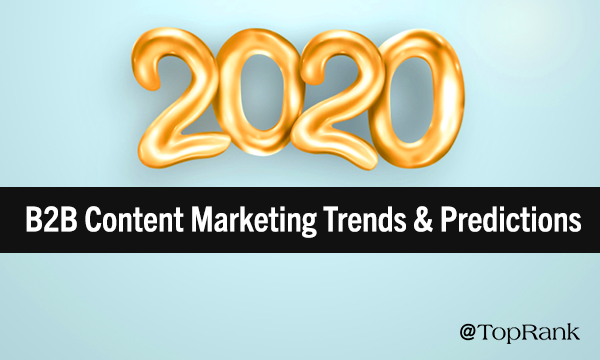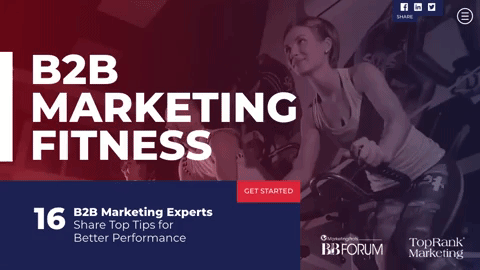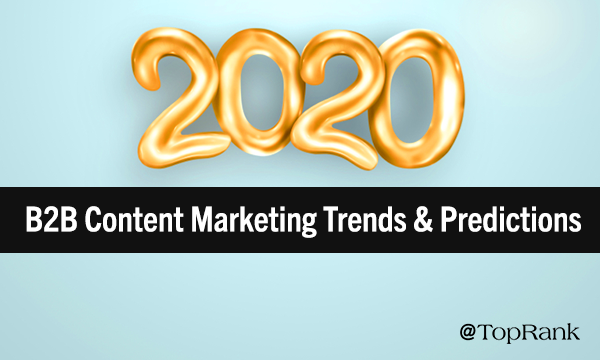
Well, B2B marketers, it’s that time of year again. The holiday season is in full swing. The countdown to a new year and a new decade has begun. And of course, we’re all channeling our psychic powers, hoping to uncover what 2020 has in store so we can seize opportunities, prepare for challenges, and ultimately improve the effectiveness of our content marketing efforts.
2019 was a bonding year for elevating experiences, with many B2B marketers making significant investments in interactive content, influencer content collaborations, and multi-faceted campaigns. 2020 will be the year where many brands will cement experience as a strategy.
So, what does this look like in 2020? Below we dive into our top 10 trends and predictions for 2020—each of which have overt or underlying ties to experience.
TopRank Marketing’s Top B2B Content Marketing Trends & Predictions for 2020
#1 – The Evolution of Experiential Content
In case you missed my opening: It’s the age of experience, marketers. Research shows that marketing leaders expect to compete on experience now and long into the future.
“Customers don’t compare you to your competitors anymore—they compare you to other positive experiences they’ve had,” Shep Hyken, seasoned customer service and experience expert, told me not long ago. “Satisfactory is a rating. Loyalty is an emotion. So, you need to figure out a way to create a lasting emotional bond.”
Satisfactory is a rating. Loyalty is an emotion. So, you need to figure out a way to create a lasting emotional bond. @Hyken #B2BContentMarketing #CX Click To TweetCertainly, creating incredible experiences doesn’t begin and end with the marketing department. But marketing chiefs and their teams have the opportunity to rise as CX leaders in 2020. How? With experiential content.
Animated, infotaining infographics. Audio-guided eBooks. Gamified power pages. Quirky quizzes. ROI calculators. Augmented reality product catalogs. Virtual reality experiences at live events. AI-powered chatbots. From simple, stand-alone assets to real-time, on-site engagement mechanisms, marketers of all interactive content sophistication levels can design interactive experiences that encourage connection and engagement with their buying audiences—and internal stakeholders.
However, when we say experiential content, we’re not just talking about interactivity or entertainment elements—that interactivity is intertwined with data and influential voices, something that will be increasingly vital in 2020.
“The sheer volume of information and media that confronts people in the business world is overwhelming and often pretty boring,” Lee Odden, TopRank Marketing’s CEO, says. “Creating compelling experiences with interactive content is one way to stand out, differentiate, and optimize for effectiveness. At the same time, buyers don’t trust advertising or brand marketing messages. Co-creating content with trusted experts brings credibility and interest to the brand message.”
Creating compelling experiences with interactive content is one way to stand out, differentiate, and optimize for effectiveness. @leeodden #B2BContentMarketing Click To TweetCheck out our latest interactive asset featuring influential voices.
#2 – Trust 2.0
Trust in marketing topped our list of 2019 content marketing trends and predictions. Security breaches, privacy concerns, political scandals, and a long-standing distrust of advertising messages had combined to create a multi-year streak of falling trust among consumers worldwide.
But consumer trust began to rebound. The 2019 Edelman Trust Barometer showed that global trust toward business increased in 21 of 26 markets, including the U.S. where 54% of respondents voiced confidence. As we head into 2020, we need to stay the course:
No. 1: Get familiar with the California Consumer Privacy Act (CCPA). As my colleague Nick Nelson wrote not long ago: “Whether through the proliferation of state-level laws like CCPA, or the eventual enactment of a similar federal legislation, it’s only a matter of time before data privacy regulations are in place across the United States.”
No. 2: Strive to be the best answer. For years, this has been TopRank Marketing’s mantra and approach, combining art and science to create quality content that informs, educates, and inspires audiences whenever and wherever they’re searching.
“Best answer content gets back to the basics,” Nick Nelson once wrote. “When done right, it’s all about delivering value and earning trust before you ask for anything.”
But don’t just take our word for it. In August 2019, Google published a reminder and primer on its core updates—specifically calling out a little thing called “E-A-T”, which stands for “Expertise, Authoritativeness and Trustworthiness.”
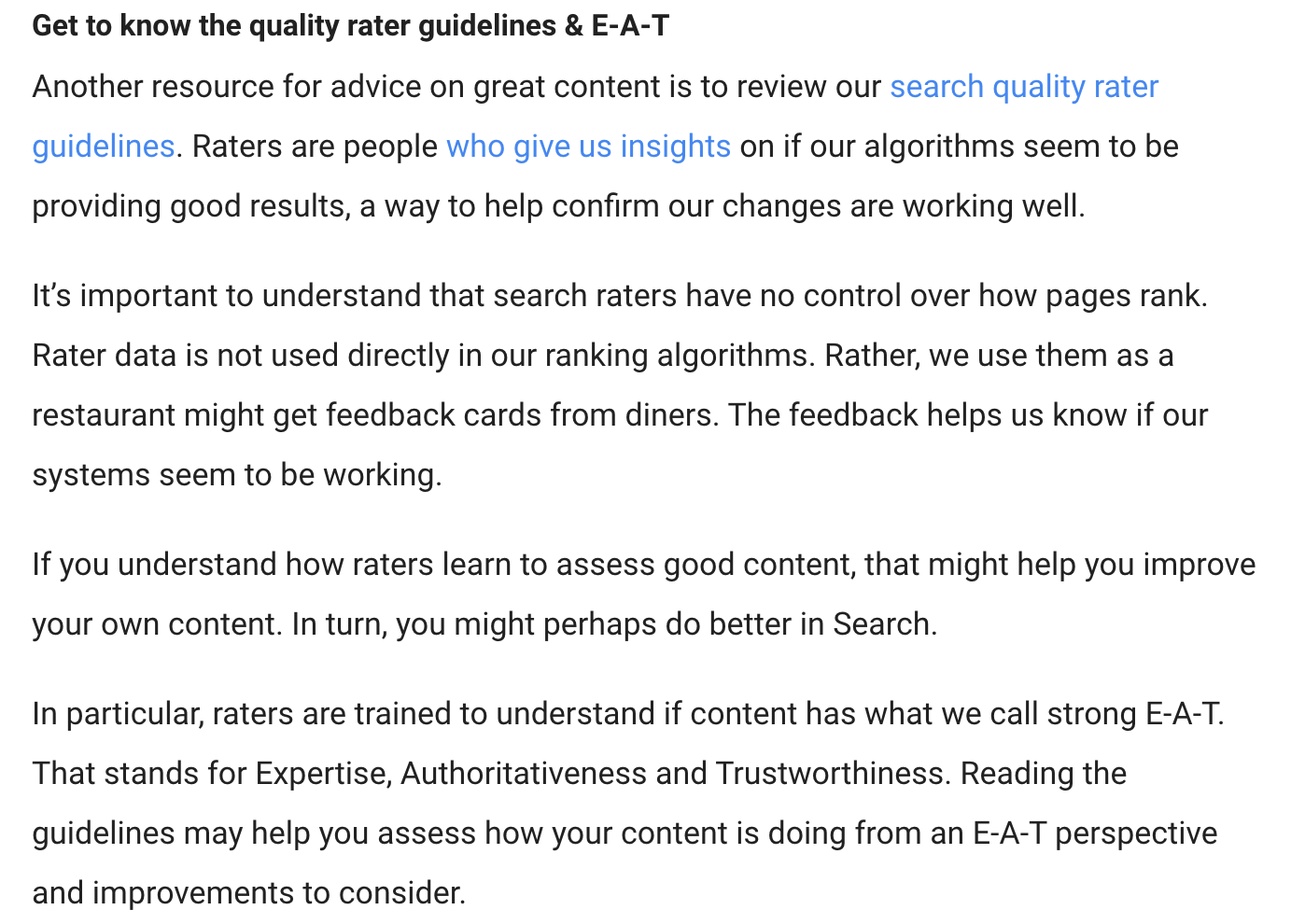
This is a huge hint, marketers. E-A-T up.
“Your brand needs to come off as credible consistently for people to trust you,” Margaret Magnarelli, Executive Director of Growth Marketing, Social Media, and SEO at Morgan Stanley, told us earlier this year. “[With content created for organic search] you have the opportunity to attract someone from a side door with a specific intent and zero brand awareness; your answer to their question will have a big impact on whether you can be trusted on more consequential matters.”
Your answer to a searcher’s question will have a big impact on whether you can be trusted on more consequential matters. @mmagnarelli #B2BContentMarketing #TrustInMarketing Click To TweetNo. 3: Align yourself with credible, influential voices. As Lee Odden says: “For any kind of content a business creates and publishes to the world, there is an opportunity for collaboration with credible voices that have active networks interested in what those voices have to say.”
Read more on this subject:
- Trust Factors: How Best Answer Content Fuels Brand Credibility
- Trust Factors: The (In)Credible Impact of B2B Influencer Marketing
- Trust Begins Within: The Vital Importance of Building Internal Trust in Marketing
#3 – The Continued Rise of Video
Last year’s annual B2B content marketing benchmarking report from Content Marketing Institute and MarketingProfs revealed that 64% of marketers increased the audio and visual content production. In this year’s report, a whopping 71% of respondents said they’ve used video content in the last year. To put that into perspective, video content outranked case studies, infographics, webinars, white papers, and eBooks.
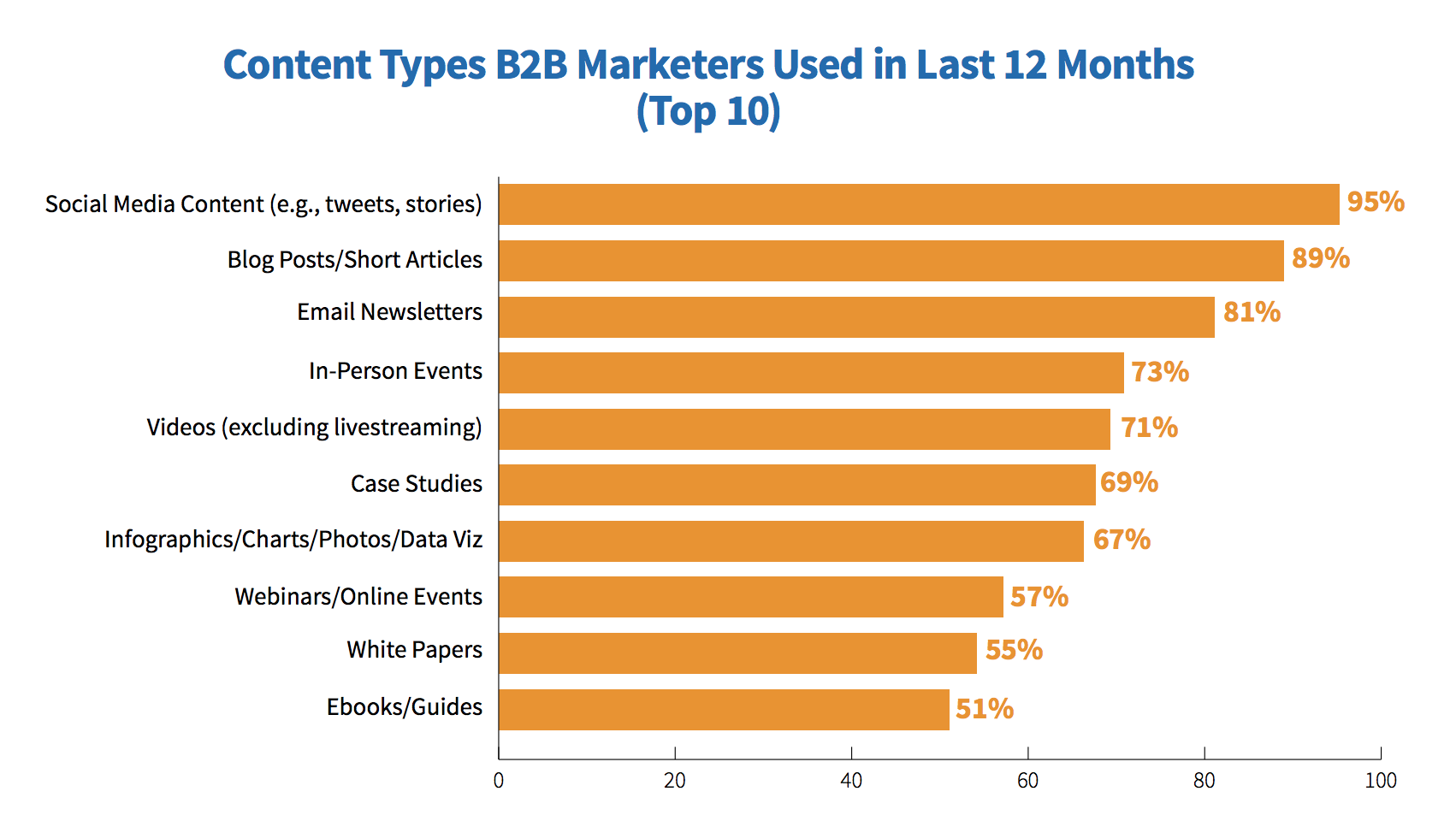
Video content production will undoubtedly grow among B2B marketers in 2020. And from our perspective, the biggest change here will be diversification in terms of strategy and storytelling.
Currently, video is often used as a top-of-funnel tactic. But video can be effective at every stage of the buyer journey. So, as marketers grow more comfortable and sophisticated in the video realm, they’ll broaden their video marketing strategies to reach prospects and nurture customers. And as video becomes more ubiquitous, constructing compelling visual narratives will be the key to success.
“If you want to make the best impact and see the highest returns for your video’s investment, you’ve got to SHOW not tell,” Andrew Davis, keynote speaker and bestselling author, says. “Instead of a talking head or another interview, how can you SHOW me? Spend more time shooting the rest of the story and immediately, you’ll take your videos from drab to show-stopping.”
If you want to make the best impact and see the highest returns for your video's investment, you've got to SHOW not tell. @DrewDavisHere #B2BContentMarketing #VideoMarketing Click To Tweet#4 – “Marketer, Play Audio Content”
Today’s easy listening radio comes in the form of serialized storytelling: podcasts.
Podcast listenership has grown rapidly over the last couple years. Nearly a quarter of all podcast listeners have gotten started in the last six months. What’s more, 51% of the U.S. population over the age of 12 has listened to a podcast.
In the B2B realm, podcasting’s full potential has yet to be unlocked—but more marketers will try in 2020.
“B2B podcasting today is where content marketing was a decade ago,” Joshua Nite, Senior Content Marketing Manager at TopRank Marketing, says. “It’s emerging as a marketing discipline. People are starting to get sophisticated about deploying and measuring podcasts. We’re seeing new tools to make it easier to launch, promote, and monetize. And despite the thousands of hours of audio out there already, there’s no sign that the market is satiated.”
People are starting to get sophisticated about deploying and measuring podcasts… And despite the thousands of hours of audio out there already, there’s no sign that the market is satiated. @NiteWrites #B2BPodcasting #B2BContentMarketing Click To TweetThat said, podcasts aren’t the only audio medium that should be on marketers’ minds heading into the New Year. According to recent research from Edison Research, more than 53 million Americans now own a smart speaker—a 36% increase in just one year.
So, if content optimized for voice search—or as the kids are calling it these days, voice-activated content—didn’t make its way into your 2019 strategy, 2020 is the year.
Read: B2B Podcasting: 20 Stats That Make the Marketing Case
#5 – Collaborative Content Ups the Personalization Ante
Content proliferation coupled with evolving consumer expectations and increased skepticism and distrust has created an intensely competitive landscape. It is known.
Personalization has arisen a content marketing savior, aiming to elevate experiences by delivering relevant, one-to-one messaging to current or prospective buyers. But the next step in the 2020 personalization game is collaborative.
Partnering with select industry influencers and thought leaders, employees, and current customers or prospects can help you create unique, topically-relevant content for your (mutual) target audiences.
When it comes to influencers, consider this tidbit from TopRank Marketing’s founder Lee Odden:
“Influencers with complementary domain expertise and networks that combine forces can offer a B2B brand the reach of a major publication but with the credibility and trust of respected influencers.”
As for leveraging customers and prospects, see what my cohort Nick Nelson has to say on user-generated content:
“Storytelling is one of the most essential tactics in content marketing, and customer-centricity is among the discipline’s central tenets. UGC presents a way to merge these two by actually making turning your customer into the storyteller. Not only is this an extremely engaging role for the individual whose content is featured, but it makes that content vastly more relatable for those consuming it.”
Finally, ponder what Jay Baer, founder of Convince & Convert, has to say about employee advocacy:
“If you have a truly differentiated customer experience, something that creates conversations, your employees will naturally echo that and amplify it and connect the dots for potential customers. They will be part of the marketing arsenal.”
#6. A Renewed Commitment to Consistency & Integration
Integrated marketing. Multichannel marketing. Omnichannel marketing. Scope and definitions differ, but the general premises of each approach is the same: consistently create positive brand experiences whenever and wherever your audience is searching.
Regardless of the preferred approach, marketers have been pursuing this directive for several years. We know that consistency and integration are the keys to effectively telling our brands’ stories and connecting with our audiences. However, in the pursuit of perfection, complexities—and perhaps even some complatency—have crept in.
We’ve added tactics. We’ve added channels. We’ve added tools. But in the midst of all the additions, have we made vast improvements in the content experiences we provide? Have we fallen in set-and-forget mode?
The aforementioned CMI and MarketingProfs study reveals that 93% of most successful B2B content marketers prioritize the delivery of relevant content when and where someone is most likely to see it—just 37% of the least successful marketers focus here. So, as experience continues its rise as a competitive differentiator, brands and marketers would do well to reassess and renew their commitments to smart marketing integration in 2020.
As experience continues its rise as a competitive differentiator, brands and marketers would do well to reassess and renew their commitments to smart marketing integration in 2020. @CaitlinMBurgess #B2BContentMarketing Click To Tweet#7. Data-Informed Content
Every B2B marketer understands the pivotal role data plays in modern content marketing. However, many still make marketing decisions based on gut-feel. Whether they feel overwhelmed by the sheer volume of data available or they don’t have the proper collection and analyzation tools in place, marketers often use just a fraction of the data that they have at their disposal.
In 2020, those who are able to focus their data lens will be able to create data-informed content that drives better experiences.
If you’re struggling with data quality, leverage this six-rule framework courtesy of Christopher Penn, Co-Founder and Chief Data Scientist at Trust Insights:
- Clean: Free from errors
- Complete: Not missing critical parts
- Comprehensive: Answers the questions asked of it
- Chosen: Does not contain irrelevant information
- Credible: Collected with as little bias as possible from reliable sources
- Calculable: Usable by both people and machines
“Data that follows these six rules is data you can use for maximum impact as a B2B marketer, the equivalent of health-giving food,” Christopher says. “Data that breaks these rules is equivalent to junk food, food that steals from your wellness.”
Clean. Complete. Comprehensive. Chosen. Credible. Calculable. Adhere to the 6 C’s of data quality and you'll be well on your way to B2B marketing fitness. @cspenn #B2BContentMarketing Click To TweetIf you’re struggling to identify the “right” data to focus on, we suggest focusing on the following customer data types:
- Discovery: Where, when, and how buyers seek and find information that helps them identify a solution.
- Consumption: The consumption channels, content types, topics, formats, devices, and experiences your customers and prospects prefer.
- Action: The triggers that have and will motivate a desired action.
“With buyer discovery, consumption, and action metrics, you’ll know how to create awareness, great customer engagement, and compelling offers that matter to your customers,” Lee Odden says. “And you’ll always know which approach to use to improve your marketing because it will be customer-driven.”
With buyer discovery, consumption, and action metrics, you’ll know how to create awareness, great customer engagement, and compelling offers that matter to your customers. @leeodden #B2BContentMarketing Click To Tweet#8. Visually-Rich Content Focused on Storytelling
It’s no longer enough to inform buyers. Instead, you must provide story-driven, visual content that connects on intellectual and emotional levels. This is critical in the experience age.
Visual platforms are where we spend our time—a trend that will absolutely continue in 2020. In fact, YouTube is the most widely used online platform among U.S. adults, according to Pew Research Center. Facebook, which has made platform changes to make visual content more easily accessible, comes in second.
But the visually-rich storytelling doesn’t begin or end with video on social platforms.
“Contrary to popular belief, people do still read traditional content forms like whitepapers, eBooks and case studies,” Michelle Liro, Vice President of Demand Generation at PTC, says. “But first you’ll need to pull them in with attention-grabbing visuals that show them what they’ll get before you tell them what they’ll get.”
Contrary to popular belief, people do still read traditional content forms like whitepapers, eBooks and case studies. But first you’ll need to pull them in with attention-grabbing visuals. @michelleliro #B2BContentMarketing Click To TweetTake a look at this internal marketing example from Antea Group*.

With the goal of educating and rallying their team of consultants around the relaunch of a core service offering, the firm tapped our team to develop an animated eBook that was fully steeped in narrative.

#9. Email Newsletters Make a Comeback
Email marketing is not dead. As we recently reported, open rates aren’t in a state of steady, ceaseless decline. In fact, according to Super Office, the average rate has generally been increasing (or at least remaining steady) year-to-year over the past decade-plus.
That said, email marketing strategies are most definitely in need of a refresh. And from our perspective, the email newsletter can make a triumphant comeback in 2020.
“My feelings about newsletters are strong,” Ann Handley, Chief Content Officer at MarketingProfs and accomplished email newsletter purveyor, once told AWeber. “It’s the one enduring place that we have as marketers, and it’s the place where conversations are most intimate. Newsletters are 100% effective and they’re still the backbone of so many content marketing efforts.”
My feelings about newsletters are strong. It’s the one enduring place that we have as marketers, and it’s the place where conversations are most intimate. Ann Handley, @MarketingProfs #B2BContentMarketing Click To TweetHowever, marketers need to be willing to put in the work to ensure those intimate conversations build relationships next year, rather than serve only as a sales pitch.
“When someone opts into your newsletter and then starts getting overtly pitched right away, it can feel like a betrayal of trust,” Nick Nelson wrote not long ago. “As a relatively direct and personal form of marketing communication, email should be used to deliver value and build brand affinity. This is not to say you must avoid any type of lead generation elements in your messages, but make them subtle and sparse.”
3. 2. 1… Look Out 2020, Here We Come!
From experimenting with new mediums such as podcasts or interactive content to innovative storytelling, marketers can and should play an integral role in crafting and advancing positive audience experiences with their brands.
So, as we head into 2020, ask yourself: Is my brand poised to deliver experiences that leave a lasting impression?
Happy New Year, B2B marketers.
What’s your B2B content marketing prediction for 2020? What trends are you watching? Tell us in the comments section below.
